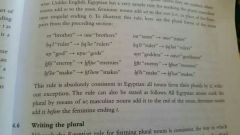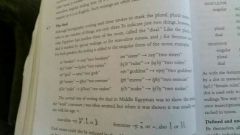![]()
![]()
![]()
Use LEFT and RIGHT arrow keys to navigate between flashcards;
Use UP and DOWN arrow keys to flip the card;
H to show hint;
A reads text to speech;
8 Cards in this Set
- Front
- Back
- 3rd side (hint)
|
What is the root of a noun? Give an example. |
The root of an Egyptian noun is the part that all nouns have in common. For example ntr, ntrw, ntrt. Ntr is the root. |
|
|
|
How does an Egyptian noun indicate its gender? |
An Egyptian noun indicates its gender by adding an ending to the root. For masculine nouns usually there is no ending, however, a j or a w may be added. For feminine nouns a t ending is added to the root. |
|
|
|
How is the number indicated on Egyptian nouns - the plural? |
Consistent rule without exception. Masculine nouns add w to the noun. Feminine nouns add t to the root. Example in hint. |

|
|
|
How is the dual indicated? |
For Masculine nouns the wj ending is added to the root. For Feminine nouns the j ending is added to the root. |

|
|
|
Explain apposition? |
Apposition means when both nouns are used together to refer to the same thing. For example zA.k Hrw 'your son, Horus'. (Side by side) in apposition of each other. |
|
|
|
Explain connection, conjunction, disjunction? |
English grammar: two nouns can be connected in a phrase by the word and ( conjunction) , nouns can also be connected by the word or (disjunction). Middle Egyptian has no specific word for and. Conjunction usually expressed by one noun following the other. Hna and Hr may also be used as and, upon. |
|
|
|
Possession - what is the direct genitive? |
A direct genitive is when one noun is juxtaposed to another noun. The possessor noun is always second. Usually translated by 'of'. |
|
|
|
What is the indirect genitive? And how is it indicated? |
Simmilar to the direct genitive however a 'genitival adjective' stands between one noun and the other. Indicated by n = A is masc sing; nw= A is masc plural/dual and nt= A is feminine regardless of number. |
|

